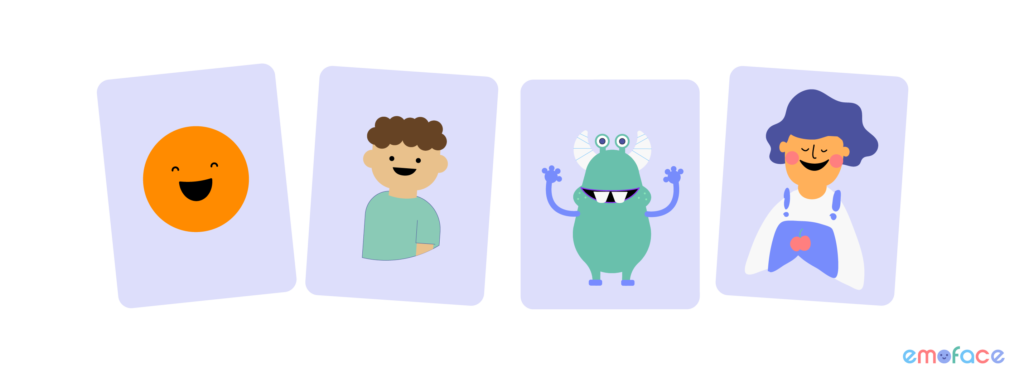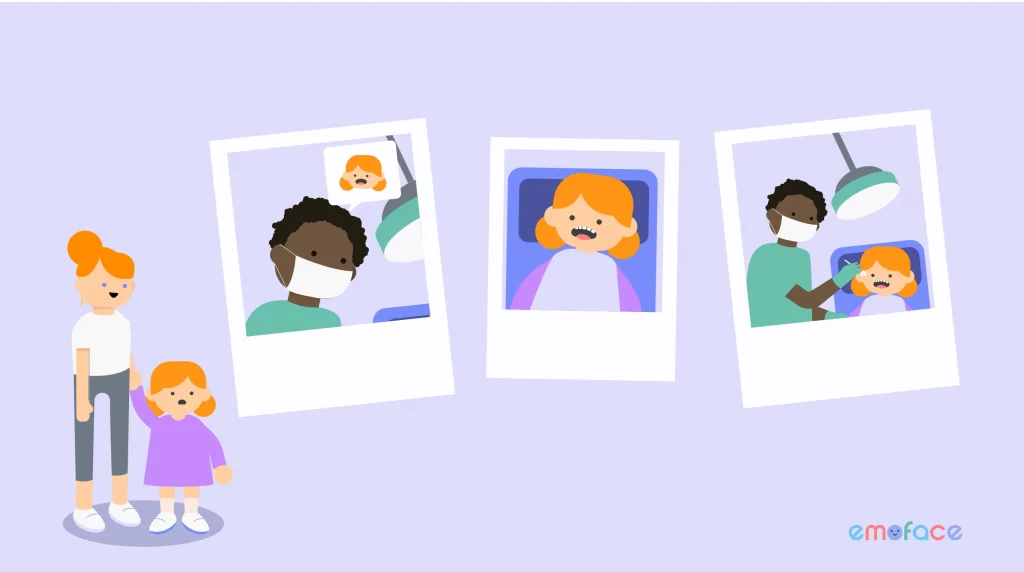Anger, joy, disgust, sadness, attachment: emotions are everywhere, all the time. They are so much a part of everyday life that it is hard to imagine how they could be difficult to understand or express. However, this is what sometimes happens, particularly in the case of a person or child suffering from autism spectrum disorder (ASD). In this article, Emoface experts help you understand emotions a little better and how autistic people understand them: what are their functions? Why work on emotions? Let’s go !
Find our previous live on learning emotions, produced with Alina Macavei, clinical psychologist.
What are emotions ?
An emotion is generally defined as a psychological and physical reaction to a situation. It has an internal manifestation, and generates an external reaction. We experience emotions introspectively: we feel them “inside ourselves”; and we can also observe its physical and physiological manifestations: it is often said that anger and fear make the heart beat faster, that shame makes you blush, that disgust causes “gagging” or even that joy makes “the eyes sparkle”.
Emotions include three essential components, all interacting within them: feeling, expressing, and reacting.
- We feel the emotion inside ourselves.
- We express it for others, by communicating verbally and with our facial expressions, the physiological changes observed.
- On réagit en agissant sur son environnement.
In reality, the current state of research on emotions does not allow us to associate a particular physical and/or physiological manifestation with each emotion. What is accepted is that emotions, and especially their expression, act as a social regulator, that is to say that emotions have several social functions, including a very important one: communication.
Facial expressions of emotions have a communication function, in the dyad (between two people) and in a group. They provide information on the potential psychological state of a person, their availability, and the message they wish to convey to their interlocutor.
Emotions are essential to decision-making, action, and social interactions.
Who do emotions concern ?
Not surprisingly, everyone feels emotions. Emotional development occurs from a very young age, and the child is capable, thanks to the observation of his environment, his peers, and the development of his ability to communicate, of emotional learning.
From a neurotypical point of view, learning about emotions and working on emotions is not often done explicitly. It is considered, for many, to be “innate”, occurring naturally during early childhood and during the child’s development. Interpersonal relationships are built around “emotional scenarios” accepted by consensus: we know how to identify situational and expressive clues allowing us to understand the emotions of others.
Result: we don’t often think about our way of learning emotions, understanding them, expressing them…
Learning emotions is not innate: the case of neurodivergent children, and particularly autistic children
For certain profiles, notably neurodivergent or neuroatypical people, the expression, recognition and management of emotions may be different. This is what happens, for example, in autistic children (ASD) or those with pervasive developmental disorders (PDD).
Due to these differences, the people concerned are sometimes confronted with difficulties with emotions; but also to difficulties in finding tools or means adapted to them to recognize and express them. This can lead, for example, to a more complicated decoding of certain social situations, or the emotions of the interlocutor.
What is very important to understand in this case is that when it comes to emotions, there will always be difficulties and misunderstandings on both sides of the equation. For example, a person with ASD may have difficulty decoding a social situation, or recognizing someone else’s emotions; and a neurotypical person may have difficulty understanding the way a person with ASD expresses emotions.
A neurotypical person also makes mistakes leading to incomprehension in the interaction. The important thing is to try to understand each other, to translate each other’s emotional language.
Can autistic people feel emotions ?
There remain many assumptions about autism, and the supposed insensitivity and lack of empathy of people with autism spectrum disorder.
The most asked question, after searching for the terms “learning emotions” and “ASD” on a search engine is: “Do autistic people have feelings?”, followed by “Why work on emotions with children ?? The myth of the person with Autism Spectrum Disorder being “emotionless” persists. This is obviously false: a person on the autism spectrum feels emotions !
What is different for a person with ASD is :
- The way of feeling: the emotions felt can be different, in terms of content, intensity, or valence. A person with ASD does not lack emotional empathy, they can even be hyper empathetic on an emotional level.
- The way of expressing them: it may be different from neurotypical people. The way a person with ASD expresses emotions may differ from what is expected by others. This can lead to being misunderstood by outsiders.
- And understanding one’s own emotions and those of others: a person with ASD can understand that someone around them feels a certain emotion, but sometimes does not understand the cause. It is then more difficult to react in the way expected by the person opposite. It is not the entire emotion that she does not understand, but the cause. The person’s current mental state may also be difficult to understand because people with ASD may have difficulty recognizing and understanding facial expressions of emotion, which express that mental state. We then speak of difficulty concerning cognitive empathy.

Why is it important to work on emotions ?
Emotions have an important social role, especially in their expression. Learning to recognize, name and interpret them can help a lot with communication.
Learning to manage your emotions also allows you to approach life with more serenity, to have solutions to be able to better manage certain situations. They can help you better understand others and how to interact with them.
Facial expressions of emotions are a very important source of information about the person producing them: about their emotional state, and their intentions. They are also a source of information about objects and events in the environment.
They can also help you to be understood: expressing your emotions can allow others to understand behaviors or reactions, or how to react in return. Succeeding in managing your emotions, but also in identifying and communicating them can open the door to many things: more communication, other learning, greater daily well-being…
What are the main emotional difficulties people with ASD encounter ?
- Difficulty recognizing facial expressions of emotion is recognized as one of the primary difficulties for people with ASD. From a very young age, this difficulty impacts the social development of children with ASD, because it prevents them from properly situating and learning the feelings and behaviors of others.
- People with ASD are often faced with the so-called “emotional sponge” phenomenon. That is to say, other people’s emotions are absorbed, and the distinction between one’s own emotions and those of others is complicated. For example, if a child comes home from school to find their parent angry because they had a bad day at work, the child will also feel angry, without really understanding why. The child may also feel guilty, even though he is not the cause of his parent’s anger. This makes managing emotions more difficult.
- Difficulties in communication and in social interactions can be linked to emotions: difficulties in expressing one’s emotions/feelings, in understanding the response expected by the other, how to act with the other, etc.
- Understanding your own emotions and your own psycho-affective functioning can also be complicated for a person with ASD. We talk about metacognition.
But we must not forget that of course, everyone’s experience is different. Each person has a different profile, and a journey that is just as different! If we talk about Autism SPECTRUM Disorders, it’s not for nothing!
Having difficulty in all of the areas listed does not mean that a person with ASD does not have emotions, or cannot understand them. Indicating these difficulties is not emphasizing an incapacity of people with ASD: it is making it clear that some people function differently. We cannot ask a neurodivergent person to adopt a different way of functioning, but we can ensure that we take into account the particularities of each person in order to make the world more inclusive and interactions more caring.

Everyone needs to work on emotions !
People with ASD may need it to better understand others, because it can help them feel better, and because they have more difficulty than a neurotypical person in recognizing, understanding and expressing their emotions and those of others. others… But everyone can benefit from it. The world is changing and we are now realizing what is good for us.
Previously, it was more common to try to hide, or deny certain emotions, more negative emotions for example… We also thought that it was something innate, on which there was no need for any work. Now, we realize that working with emotions benefits everyone, and it is very important: a person who knows how to manage their emotions has tools that will be useful to them to feel better on a daily basis and approach life more calmly.
Dans les classes de maternelle, qui sont souvent le début de l’apprentissage de la vie en collectivité, le travail sur les émotions et la gestion émotionnelle permet de mieux passer ce cap, et d’acquérir de meilleures compétences sociales plus tôt. À tout âge, lorsque les enfants sont écoutés et que leurs émotions sont prises en considération, cette attitude bienveillante suscite une plus grande motivation, plus de créativité, une meilleure stabilisation de l’humeur…
It is very important for everyone to learn more about emotions. For example, to understand that a 3-year-old child does not throw a tantrum when he rolls on the floor at the supermarket because you don’t want to buy him something. He simply does not have the emotional maturity necessary to manage his frustration. The important thing is to show him the solution, to guide him towards the most appropriate behavior.
Emotional skills, like all kinds of skills, need to be worked on throughout life. Working on emotions can be introduced at school, but we can also work on emotions on a daily basis, as a parent, with our children.
As an adult, it is also possible to work on your emotions. It is even important to do so: giving yourself the opportunity to mature emotionally, to learn new techniques to manage your emotions, or to learn to properly identify your own emotions can only be beneficial on a daily basis.
Learn emotions while having fun with Emoface !
If you or your child would like to complete or begin learning emotions, EMOFACE Play & Learn Emotions is a way to practice regularly! You can learn while playing, accompanied by our intelligent 3D avatars.
Download the app from the App Store
Download the app from the Play Store
Find us on social media:
For all your questions, or if you would like to share your experience on learning emotions : Contact us




